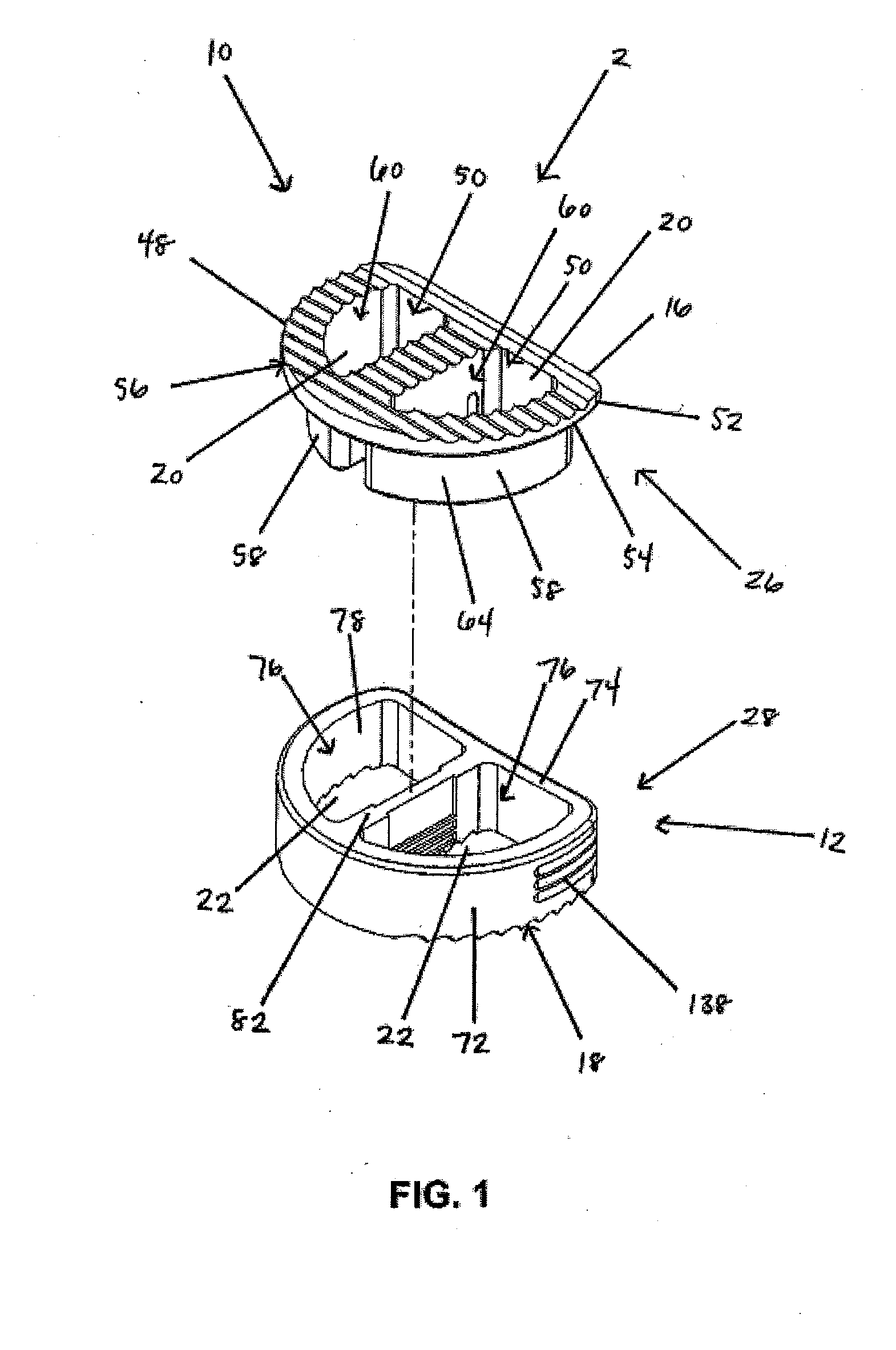Implant for Deploying Bone Graft Material and Methods Thereof
a bone graft and implant technology, applied in the field of implant devices carrying bone graft material, can solve the problems of vertebral disc bulging or herniation, impinging on the nerves of the spine, and the support surfaces of existing intervertebral implants are typically not exactly the same as the superior and inferior surfaces, or endplates, of adjacent vertebrae, so as to improve the fusion between vertebrae.
- Summary
- Abstract
- Description
- Claims
- Application Information
AI Technical Summary
Benefits of technology
Problems solved by technology
Method used
Image
Examples
first embodiment
[0125]In a first embodiment, as shown in FIGS. 1-19, the implant 2 includes a first implant extrusion member 26 and a second implant extrusion member 28. The first implant extrusion member 26 includes an upper portion 48 for engaging a vertebral body. The upper portion includes an upper vertebral engaging surface 16 for engaging a facing vertebral body 6, an opening 50 of the upper surface 16 and an annular outer edge 52. Further, the upper portion 48 includes a lower surface 54 for engaging the second implant extrusion member. In addition, the first implant extrusion member 26 includes a depending wall portion 58 extending about a first cavity portion 60. The depending portion 58 is offset from the outer edge 52 of the upper portion 48 and extends from the opening 50 of the upper portion 48 downwardly a predetermined distance 62. As shown in FIG. 1, the depending portion 58 includes a generally continuous arcuate wall portion 64 extending around the first cavity portion 60. The cav...
third embodiment
[0142]In a third embodiment, such as shown in FIGS. 39-58, the first implant extrusion member 146 includes an arcuate wall 154 extending about a cavity 152. The wall 154 further includes upper and lower vertebral engagement surfaces 148 and 150 for engaging adjacent vertebrae 6 and 8. The wall 154 of the first implant extrusion member 146 further includes a throughbore 156 for receiving the second implant extrusion member 158 therein and allowing the second implant extrusion member 158 to shift therethrough to the implantation configuration 32.
[0143]To ease insertion of the second implant extrusion member 158 into the cavity 152 and through the bone graft material 34, the distal end 160 thereof can be tapered, such as with a conical distal end configuration 162 as shown in FIG. 39.
[0144]The pre-implantation configuration 30 of the first and second implant extrusion members 146 and 158 can be defined by the second implant extrusion member 158 being at any location other than that def...
fourth embodiment
[0152]In a fourth embodiment, as shown in FIGS. 59-75, the first and second implant extrusion members 194 and 196 have a ratchet connection 198 and are configured to be shifted laterally along the ratchet connection 198 relative to one another between adjacent vertebrae 6 and 8 from the pre-implantation configuration 30 to the implantation configuration 32. As shown in FIGS. 59 and 60, the first implant extrusion member 194 includes an arcuate wall 202 having opposite ends 200 thereof. The arcuate wall portion 202 includes a first upper vertebral engaging surface 204 and a first lower vertebral engaging surface 206 for engaging the faces of adjacent vertebral bodies 6 and 8.
[0153]Further, the end portions 200 of the first implant extrusion member 194 include pawl portions 208 extending therefrom. The pawl portions 208 include a wall portion 210, with the lower surface 212 of the pawl wall portion 210 positioned above the first lower vertebral engaging surface 206 and the pawl wall u...
PUM
| Property | Measurement | Unit |
|---|---|---|
| size | aaaaa | aaaaa |
| area | aaaaa | aaaaa |
| viscosities | aaaaa | aaaaa |
Abstract
Description
Claims
Application Information
 Login to View More
Login to View More - R&D
- Intellectual Property
- Life Sciences
- Materials
- Tech Scout
- Unparalleled Data Quality
- Higher Quality Content
- 60% Fewer Hallucinations
Browse by: Latest US Patents, China's latest patents, Technical Efficacy Thesaurus, Application Domain, Technology Topic, Popular Technical Reports.
© 2025 PatSnap. All rights reserved.Legal|Privacy policy|Modern Slavery Act Transparency Statement|Sitemap|About US| Contact US: help@patsnap.com



